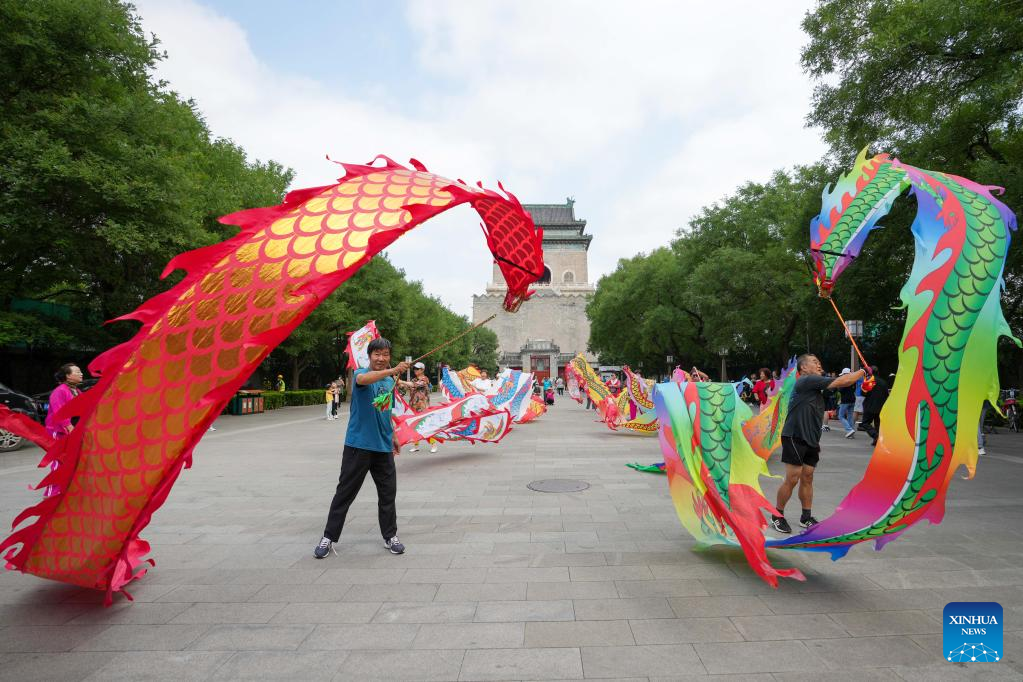
Citizens exercise at the square of the Bell and Drum Towers in Beijing, capital of China, Aug. 29, 2022. Chinese authorities have planned to recommend the Beijing Central Axis as China's 2024 world cultural heritage application project, according to the National Cultural Heritage Administration.
The Beijing Central Axis is 7.8 kilometers long, starting from the Yongding Gate in the south of the city and ending with the Drum Tower and Bell Tower in the north. Most of the major old-city buildings of Beijing are along this axis.
The central axis is the backbone of old Beijing, representing the highest achievement in the planning, design and construction of an ancient capital of Eastern civilization.
The axis was extended in 2003 as the city prepared for the 2008 Olympic Games.
Beijing authorities' general plan states that the current axis extension stretches to the Yanshan Mountain Range to the north and Beijing Daxing International Airport in the south. (Xinhua/Ju Huanzong)
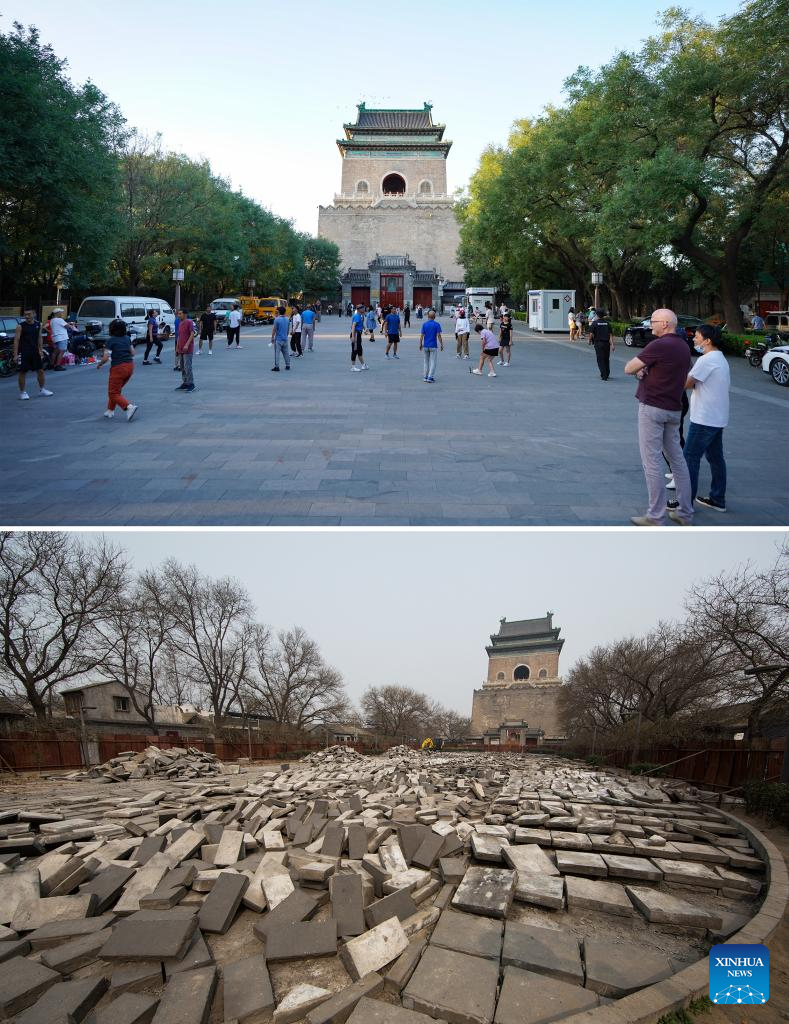
Combo photo shows citizens exercising at the square of the Bell and Drum Towers in Beijing, capital of China, Sept. 18, 2022 (up, photo taken by Chen Zhonghao) and the square of the Bell and Drum Towers under renovation in Beijing, capital of China, on March 25, 2014 (down, photo taken by Li Hui). Chinese authorities have planned to recommend the Beijing Central Axis as China's 2024 world cultural heritage application project, according to the National Cultural Heritage Administration.
The Beijing Central Axis is 7.8 kilometers long, starting from the Yongding Gate in the south of the city and ending with the Drum Tower and Bell Tower in the north. Most of the major old-city buildings of Beijing are along this axis.
The central axis is the backbone of old Beijing, representing the highest achievement in the planning, design and construction of an ancient capital of Eastern civilization.
The axis was extended in 2003 as the city prepared for the 2008 Olympic Games.
Beijing authorities' general plan states that the current axis extension stretches to the Yanshan Mountain Range to the north and Beijing Daxing International Airport in the south. (Xinhua)
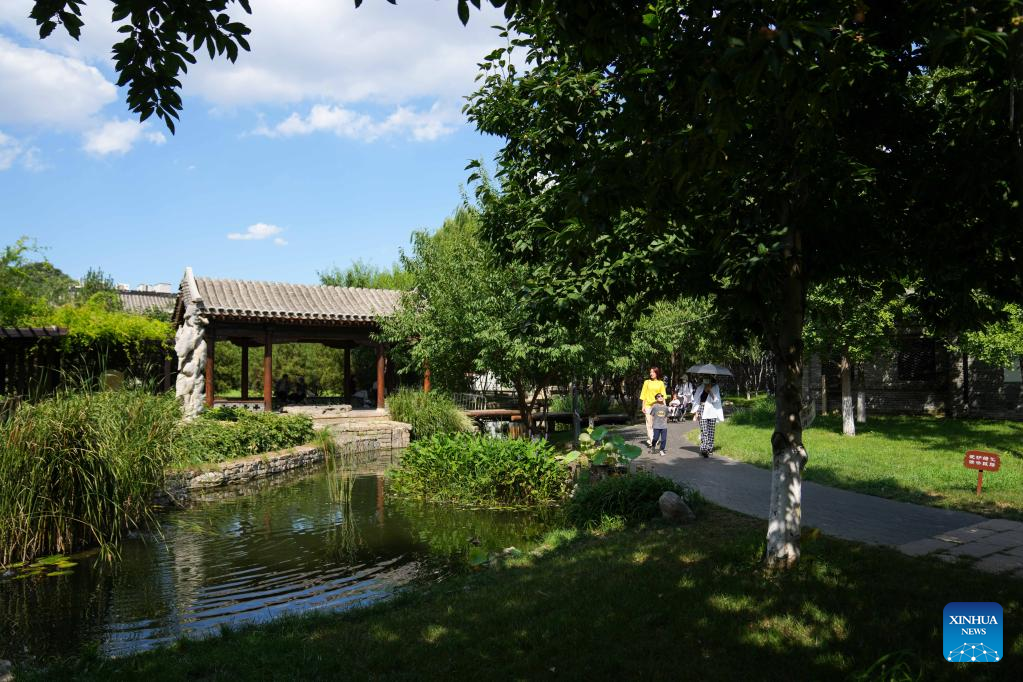
People visit the Sanlihe park of Dongcheng District in Beijing, capital of China, Aug. 16, 2022. Chinese authorities have planned to recommend the Beijing Central Axis as China's 2024 world cultural heritage application project, according to the National Cultural Heritage Administration.
The Beijing Central Axis is 7.8 kilometers long, starting from the Yongding Gate in the south of the city and ending with the Drum Tower and Bell Tower in the north. Most of the major old-city buildings of Beijing are along this axis.
The central axis is the backbone of old Beijing, representing the highest achievement in the planning, design and construction of an ancient capital of Eastern civilization.
The axis was extended in 2003 as the city prepared for the 2008 Olympic Games.
Beijing authorities' general plan states that the current axis extension stretches to the Yanshan Mountain Range to the north and Beijing Daxing International Airport in the south. (Xinhua/Ju Huanzong)
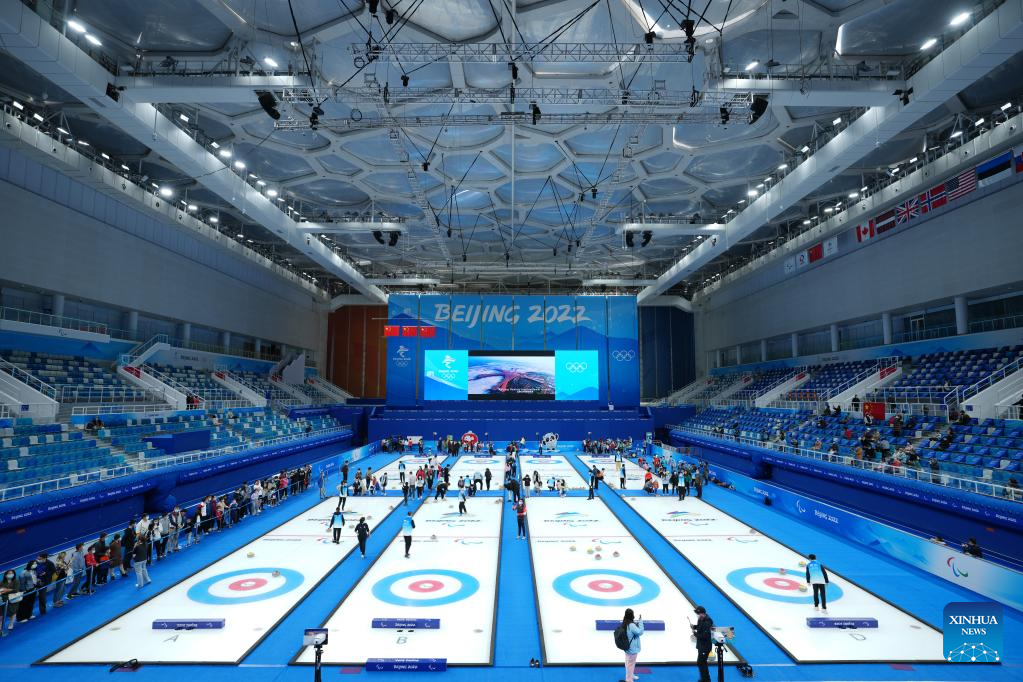
People visit the National Aquatics Center, also known as the Ice Cube, in Beijing, capital of China, April 16, 2022. Chinese authorities have planned to recommend the Beijing Central Axis as China's 2024 world cultural heritage application project, according to the National Cultural Heritage Administration.
The Beijing Central Axis is 7.8 kilometers long, starting from the Yongding Gate in the south of the city and ending with the Drum Tower and Bell Tower in the north. Most of the major old-city buildings of Beijing are along this axis.
The central axis is the backbone of old Beijing, representing the highest achievement in the planning, design and construction of an ancient capital of Eastern civilization.
The axis was extended in 2003 as the city prepared for the 2008 Olympic Games.
Beijing authorities' general plan states that the current axis extension stretches to the Yanshan Mountain Range to the north and Beijing Daxing International Airport in the south. (Xinhua/Ju Huanzong)

A tourist poses for photos at the National Speed Skating Oval in Beijing, capital of China, July 9, 2022. Chinese authorities have planned to recommend the Beijing Central Axis as China's 2024 world cultural heritage application project, according to the National Cultural Heritage Administration.
The Beijing Central Axis is 7.8 kilometers long, starting from the Yongding Gate in the south of the city and ending with the Drum Tower and Bell Tower in the north. Most of the major old-city buildings of Beijing are along this axis.
The central axis is the backbone of old Beijing, representing the highest achievement in the planning, design and construction of an ancient capital of Eastern civilization.
The axis was extended in 2003 as the city prepared for the 2008 Olympic Games.
Beijing authorities' general plan states that the current axis extension stretches to the Yanshan Mountain Range to the north and Beijing Daxing International Airport in the south. (Xinhua/Ju Huanzong)
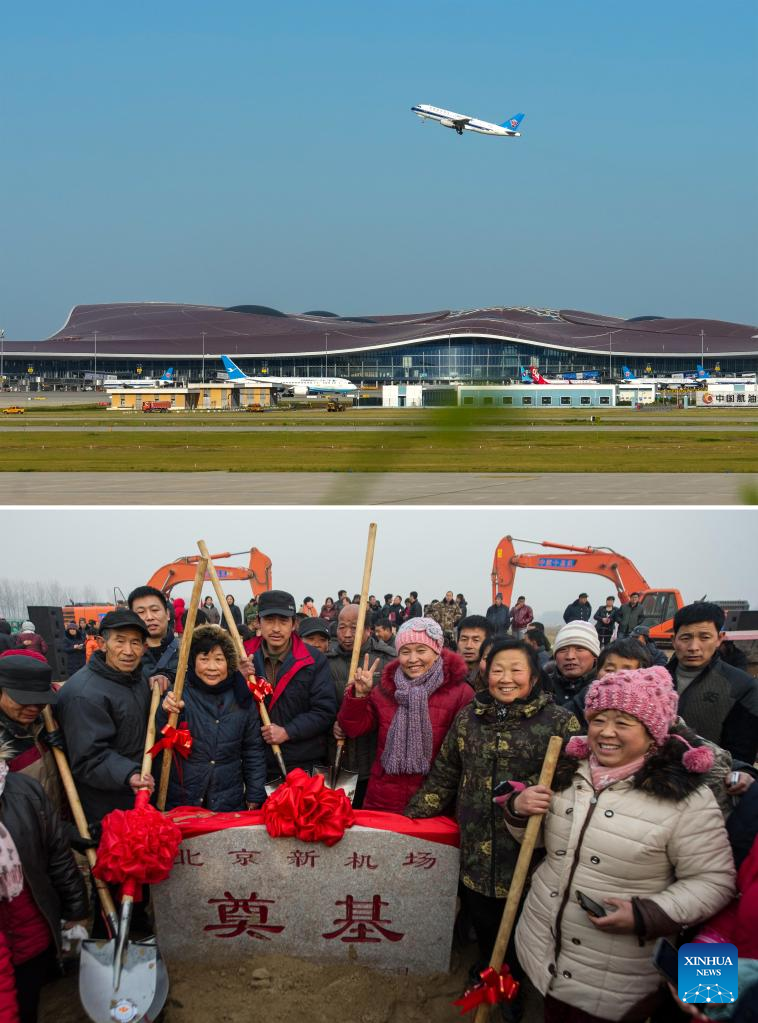
Combo photo shows a plane taking off from Beijing Daxing International Airport in Beijing, capital of China on Sept. 7, 2022 (up, photo taken by Ju Huanzong) and local villagers posing with the foundation stone at the ground breaking ceremony of Beijing Daxing International Airport in the Daxing District of Beijing, capital of China, Dec. 26, 2014 (down, photo taken by Luo Xiaoguang) . Chinese authorities have planned to recommend the Beijing Central Axis as China's 2024 world cultural heritage application project, according to the National Cultural Heritage Administration.
The Beijing Central Axis is 7.8 kilometers long, starting from the Yongding Gate in the south of the city and ending with the Drum Tower and Bell Tower in the north. Most of the major old-city buildings of Beijing are along this axis.
The central axis is the backbone of old Beijing, representing the highest achievement in the planning, design and construction of an ancient capital of Eastern civilization.
The axis was extended in 2003 as the city prepared for the 2008 Olympic Games.
Beijing authorities' general plan states that the current axis extension stretches to the Yanshan Mountain Range to the north and Beijing Daxing International Airport in the south. (Xinhua)
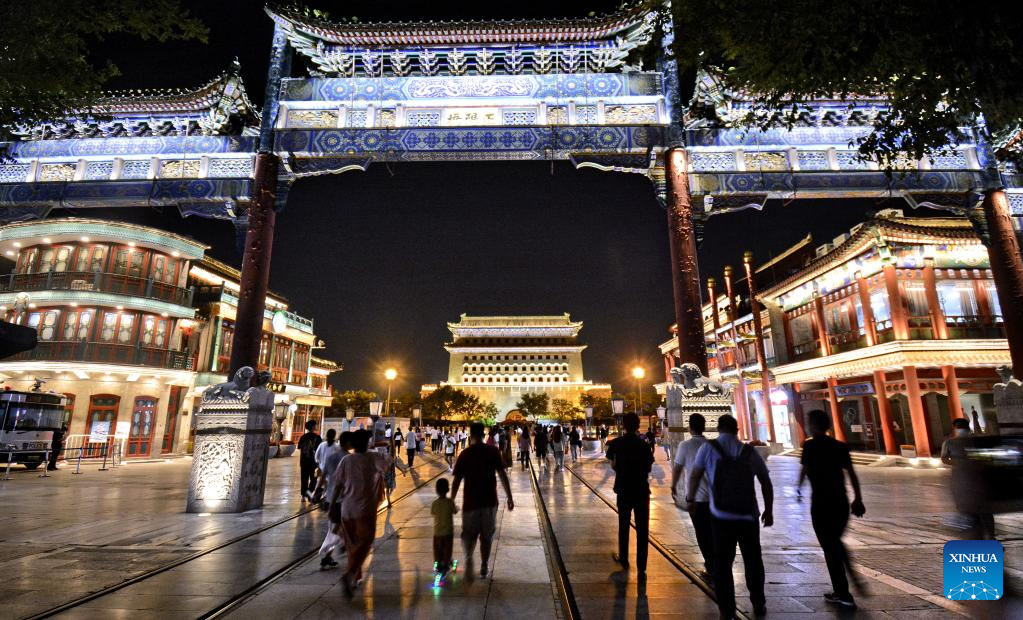
Citizens visit Qianmen Street, a landmark commercial street in Beijing, capital of China, July 6, 2022. Chinese authorities have planned to recommend the Beijing Central Axis as China's 2024 world cultural heritage application project, according to the National Cultural Heritage Administration.
The Beijing Central Axis is 7.8 kilometers long, starting from the Yongding Gate in the south of the city and ending with the Drum Tower and Bell Tower in the north. Most of the major old-city buildings of Beijing are along this axis.
The central axis is the backbone of old Beijing, representing the highest achievement in the planning, design and construction of an ancient capital of Eastern civilization.
The axis was extended in 2003 as the city prepared for the 2008 Olympic Games.
Beijing authorities' general plan states that the current axis extension stretches to the Yanshan Mountain Range to the north and Beijing Daxing International Airport in the south. (Xinhua/Li Xin)
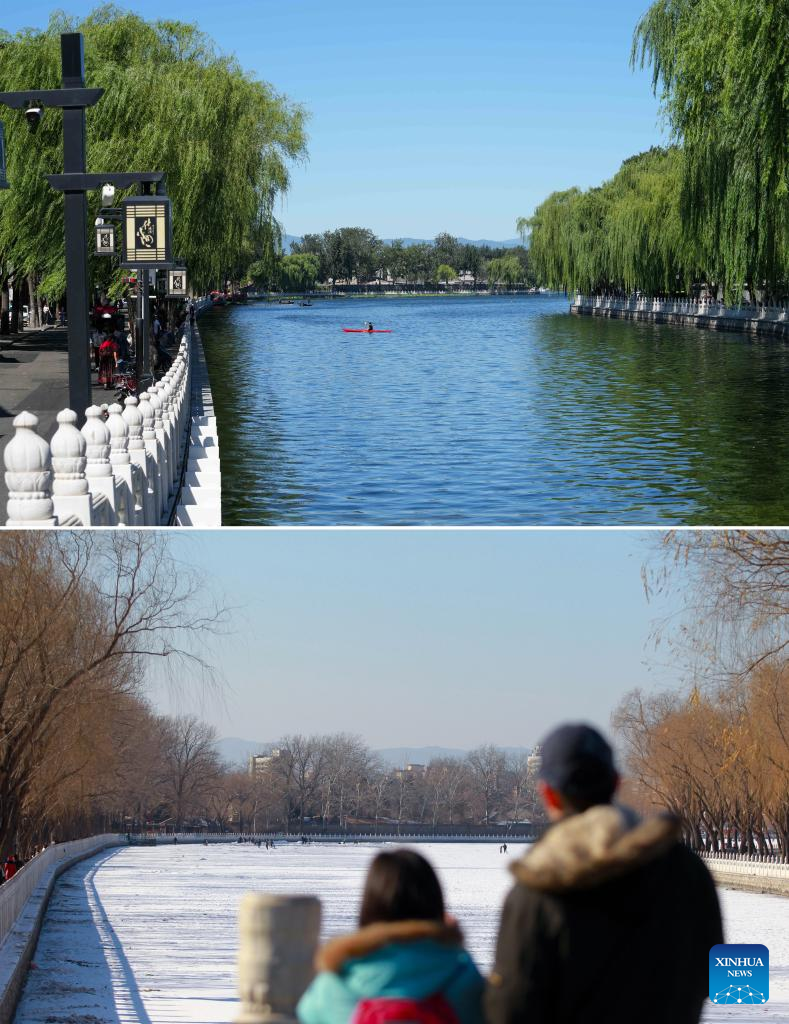
Combo photo shows the mountain view seen on Yinding Bridge in Shichahai scenic spot in Beijing, capital of China, on Aug. 31, 2022 (up, photo taken by Ju Huanzong) and Feb. 4, 2013 (down, photo taken by Shi Chunyang). Chinese authorities have planned to recommend the Beijing Central Axis as China's 2024 world cultural heritage application project, according to the National Cultural Heritage Administration.
The Beijing Central Axis is 7.8 kilometers long, starting from the Yongding Gate in the south of the city and ending with the Drum Tower and Bell Tower in the north. Most of the major old-city buildings of Beijing are along this axis.
The central axis is the backbone of old Beijing, representing the highest achievement in the planning, design and construction of an ancient capital of Eastern civilization.
The axis was extended in 2003 as the city prepared for the 2008 Olympic Games.
Beijing authorities' general plan states that the current axis extension stretches to the Yanshan Mountain Range to the north and Beijing Daxing International Airport in the south. (Xinhua)
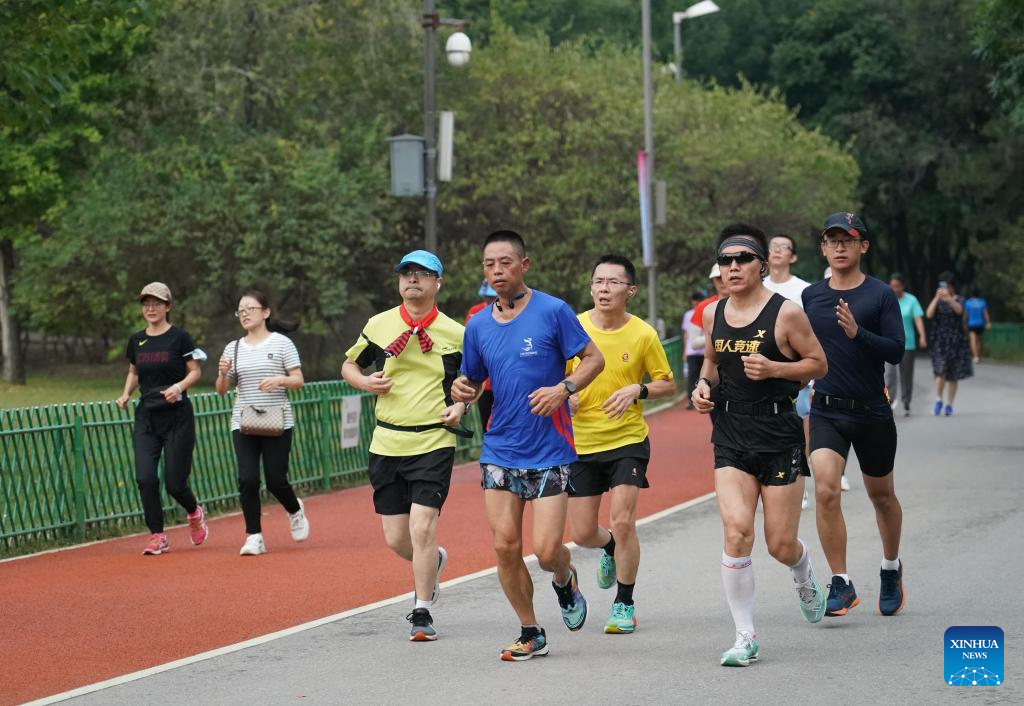
People run at the Olympic Forest Park in Beijing, capital of China, Sept 11, 2022. Chinese authorities have planned to recommend the Beijing Central Axis as China's 2024 world cultural heritage application project, according to the National Cultural Heritage Administration.
The Beijing Central Axis is 7.8 kilometers long, starting from the Yongding Gate in the south of the city and ending with the Drum Tower and Bell Tower in the north. Most of the major old-city buildings of Beijing are along this axis.
The central axis is the backbone of old Beijing, representing the highest achievement in the planning, design and construction of an ancient capital of Eastern civilization.
The axis was extended in 2003 as the city prepared for the 2008 Olympic Games.
Beijing authorities' general plan states that the current axis extension stretches to the Yanshan Mountain Range to the north and Beijing Daxing International Airport in the south. (Xinhua/Ren Chao)

Photo taken on June 23, 2022 shows an aerial view of China's National Stadium (L) and National Aquatics Center in Beijing, capital of China. Chinese authorities have planned to recommend the Beijing Central Axis as China's 2024 world cultural heritage application project, according to the National Cultural Heritage Administration.
The Beijing Central Axis is 7.8 kilometers long, starting from the Yongding Gate in the south of the city and ending with the Drum Tower and Bell Tower in the north. Most of the major old-city buildings of Beijing are along this axis.
The central axis is the backbone of old Beijing, representing the highest achievement in the planning, design and construction of an ancient capital of Eastern civilization.
The axis was extended in 2003 as the city prepared for the 2008 Olympic Games.
Beijing authorities' general plan states that the current axis extension stretches to the Yanshan Mountain Range to the north and Beijing Daxing International Airport in the south. (Xinhua/Zhang Chenlin)
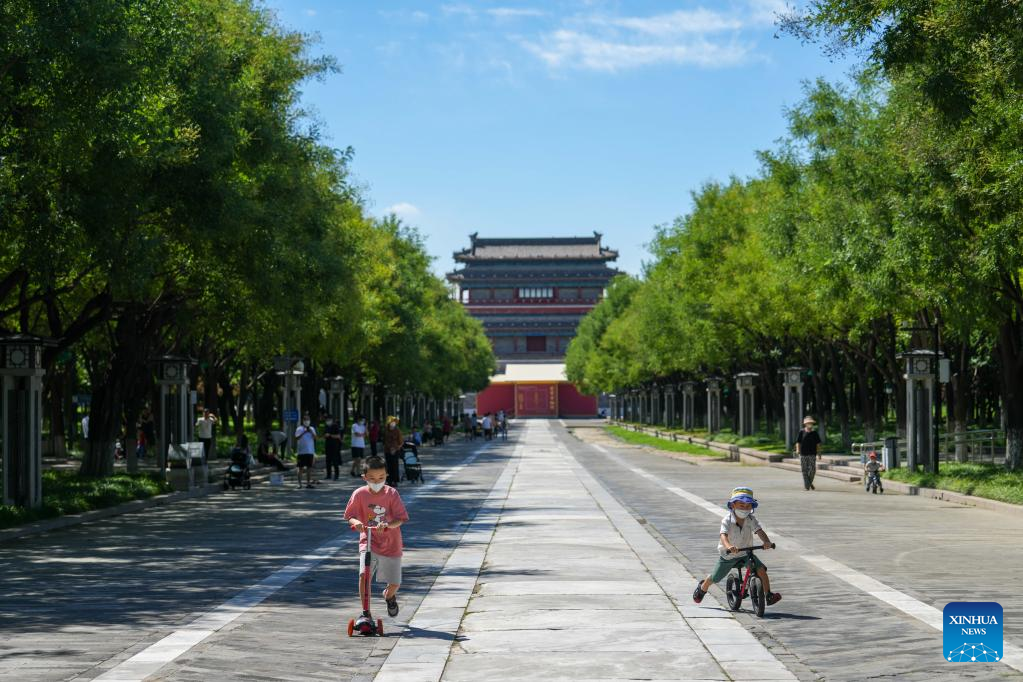
Two children play at the scenic area of south central axis in Yongdingmen Park in Beijing, capital of China, Aug. 16, 2022. Chinese authorities have planned to recommend the Beijing Central Axis as China's 2024 world cultural heritage application project, according to the National Cultural Heritage Administration.
The Beijing Central Axis is 7.8 kilometers long, starting from the Yongding Gate in the south of the city and ending with the Drum Tower and Bell Tower in the north. Most of the major old-city buildings of Beijing are along this axis.
The central axis is the backbone of old Beijing, representing the highest achievement in the planning, design and construction of an ancient capital of Eastern civilization.
The axis was extended in 2003 as the city prepared for the 2008 Olympic Games.
Beijing authorities' general plan states that the current axis extension stretches to the Yanshan Mountain Range to the north and Beijing Daxing International Airport in the south. (Xinhua/Ju Huanzong)
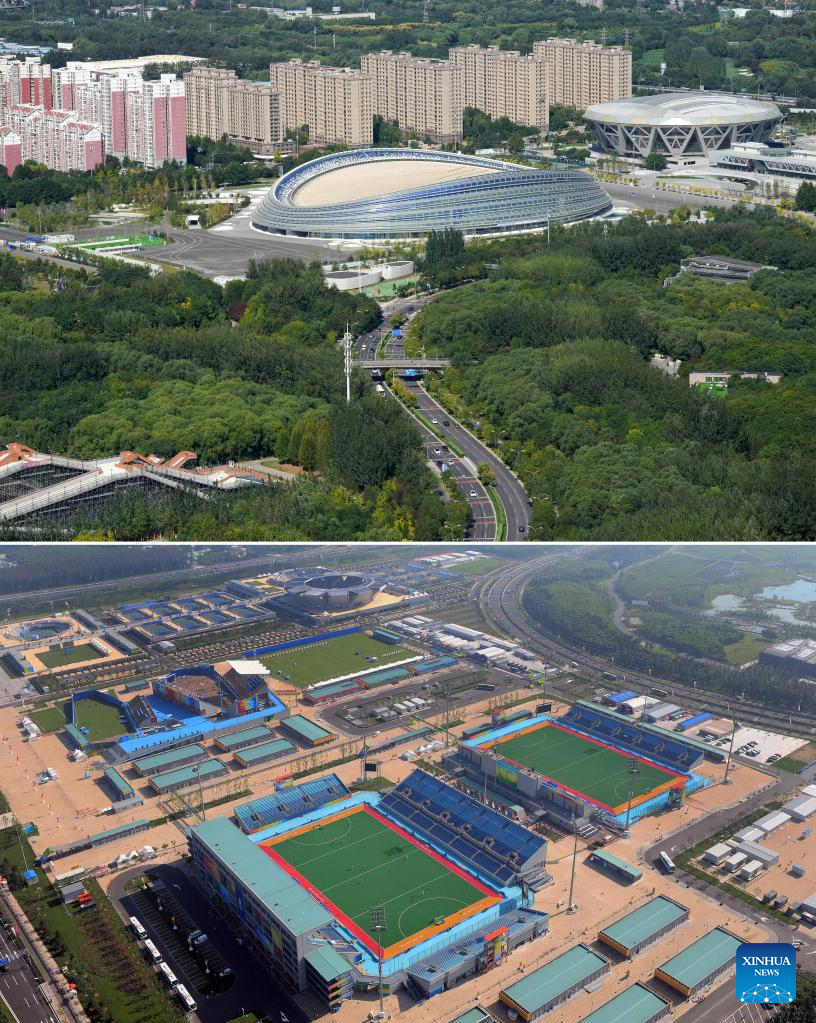
Combo photo shows the National Speed Skating Oval, known as the Ice Ribbon, which was built on a temporary site for Hockey and Archery during the 2008 Olympics, in Beijing, capital of China on Sept. 19, 2022 (up, photo taken by Ju Huanzong) and the Beijing Olympic Green Hockey Stadium in Beijing, capital of China, on Aug. 2, 2008 (down, photo taken by Chen Kai) . Chinese authorities have planned to recommend the Beijing Central Axis as China's 2024 world cultural heritage application project, according to the National Cultural Heritage Administration.
The Beijing Central Axis is 7.8 kilometers long, starting from the Yongding Gate in the south of the city and ending with the Drum Tower and Bell Tower in the north. Most of the major old-city buildings of Beijing are along this axis.
The central axis is the backbone of old Beijing, representing the highest achievement in the planning, design and construction of an ancient capital of Eastern civilization.
The axis was extended in 2003 as the city prepared for the 2008 Olympic Games.
Beijing authorities' general plan states that the current axis extension stretches to the Yanshan Mountain Range to the north and Beijing Daxing International Airport in the south. (Xinhua)
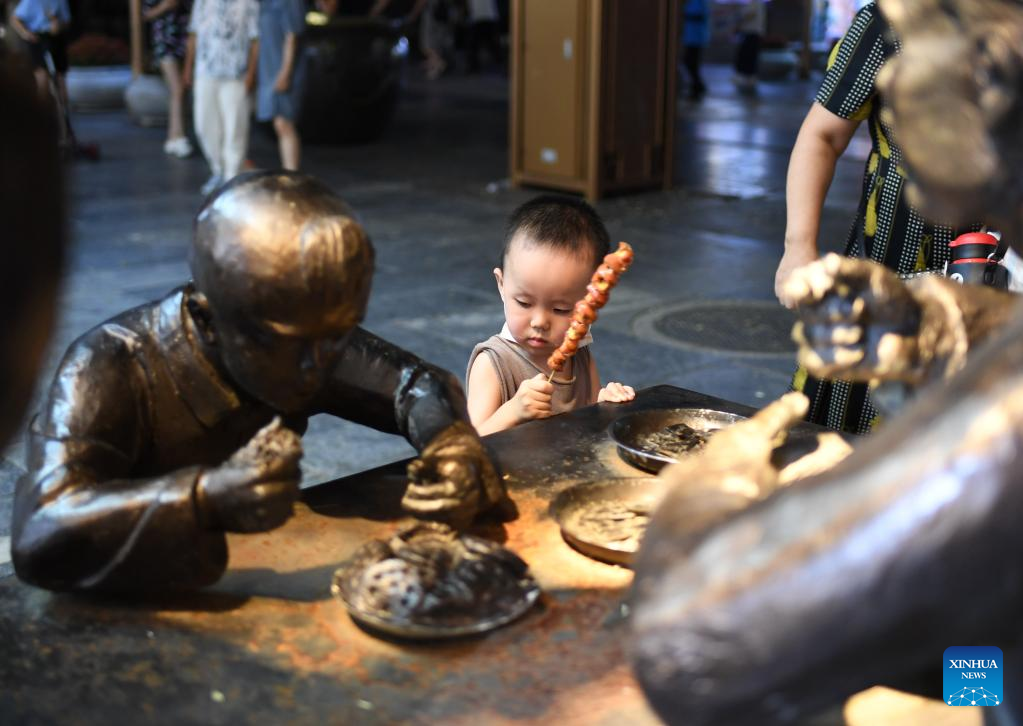
A child visits Qianmen Street, a landmark commercial street in Beijing, capital of China, July 16, 2022. Chinese authorities have planned to recommend the Beijing Central Axis as China's 2024 world cultural heritage application project, according to the National Cultural Heritage Administration.
The Beijing Central Axis is 7.8 kilometers long, starting from the Yongding Gate in the south of the city and ending with the Drum Tower and Bell Tower in the north. Most of the major old-city buildings of Beijing are along this axis.
The central axis is the backbone of old Beijing, representing the highest achievement in the planning, design and construction of an ancient capital of Eastern civilization.
The axis was extended in 2003 as the city prepared for the 2008 Olympic Games.
Beijing authorities' general plan states that the current axis extension stretches to the Yanshan Mountain Range to the north and Beijing Daxing International Airport in the south. (Xinhua/Zhang Chenlin)
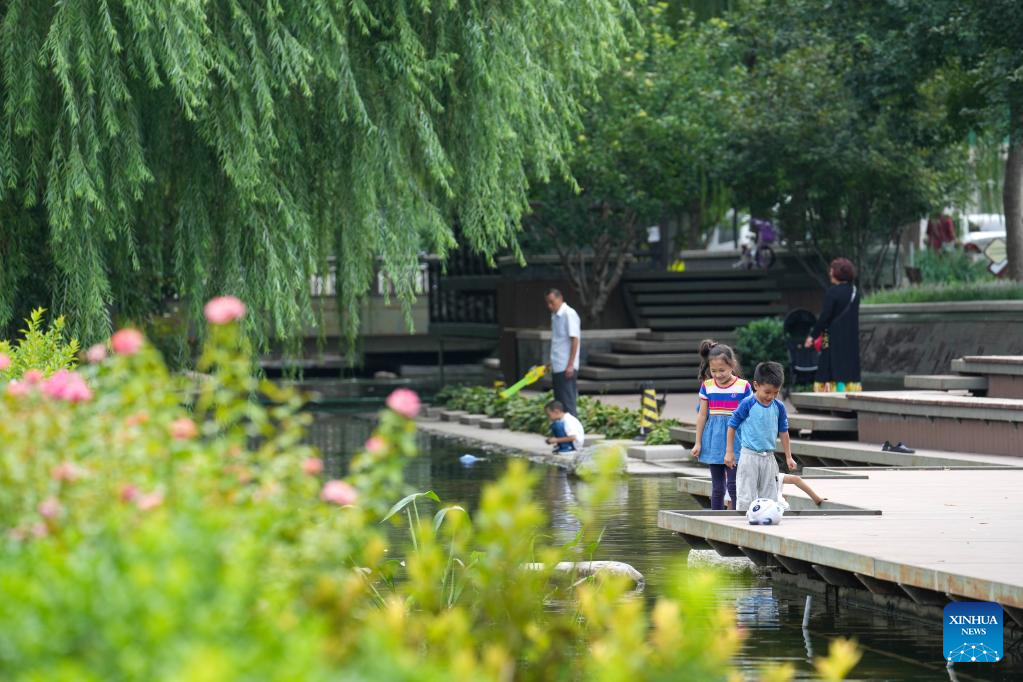
People play at the Dongcheng section of the Yuhe river in Beijing, capital of China, on Aug 29, 2022. Chinese authorities have planned to recommend the Beijing Central Axis as China's 2024 world cultural heritage application project, according to the National Cultural Heritage Administration.
The Beijing Central Axis is 7.8 kilometers long, starting from the Yongding Gate in the south of the city and ending with the Drum Tower and Bell Tower in the north. Most of the major old-city buildings of Beijing are along this axis.
The central axis is the backbone of old Beijing, representing the highest achievement in the planning, design and construction of an ancient capital of Eastern civilization.
The axis was extended in 2003 as the city prepared for the 2008 Olympic Games.
Beijing authorities' general plan states that the current axis extension stretches to the Yanshan Mountain Range to the north and Beijing Daxing International Airport in the south. (Xinhua/Ju Huanzong)
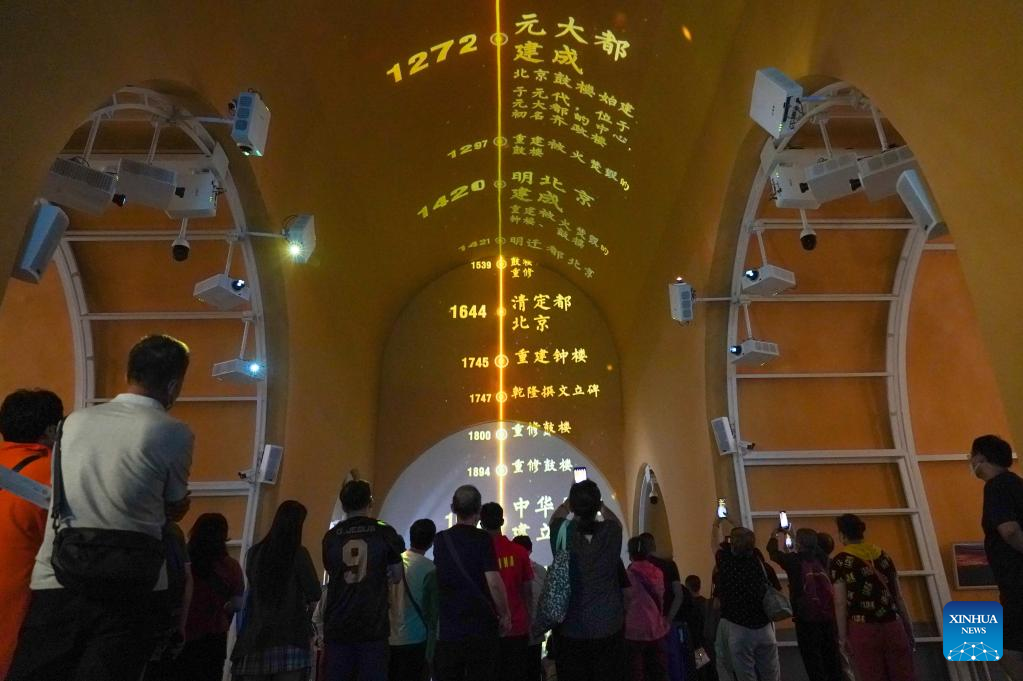
People visit an exhibition at the ground floor of Gulou, a historic drum tower, in Beijing, capital of China, Aug. 28, 2022. Chinese authorities have planned to recommend the Beijing Central Axis as China's 2024 world cultural heritage application project, according to the National Cultural Heritage Administration.
The Beijing Central Axis is 7.8 kilometers long, starting from the Yongding Gate in the south of the city and ending with the Drum Tower and Bell Tower in the north. Most of the major old-city buildings of Beijing are along this axis.
The central axis is the backbone of old Beijing, representing the highest achievement in the planning, design and construction of an ancient capital of Eastern civilization.
The axis was extended in 2003 as the city prepared for the 2008 Olympic Games.
Beijing authorities' general plan states that the current axis extension stretches to the Yanshan Mountain Range to the north and Beijing Daxing International Airport in the south. (Xinhua/Chen Zhonghao)
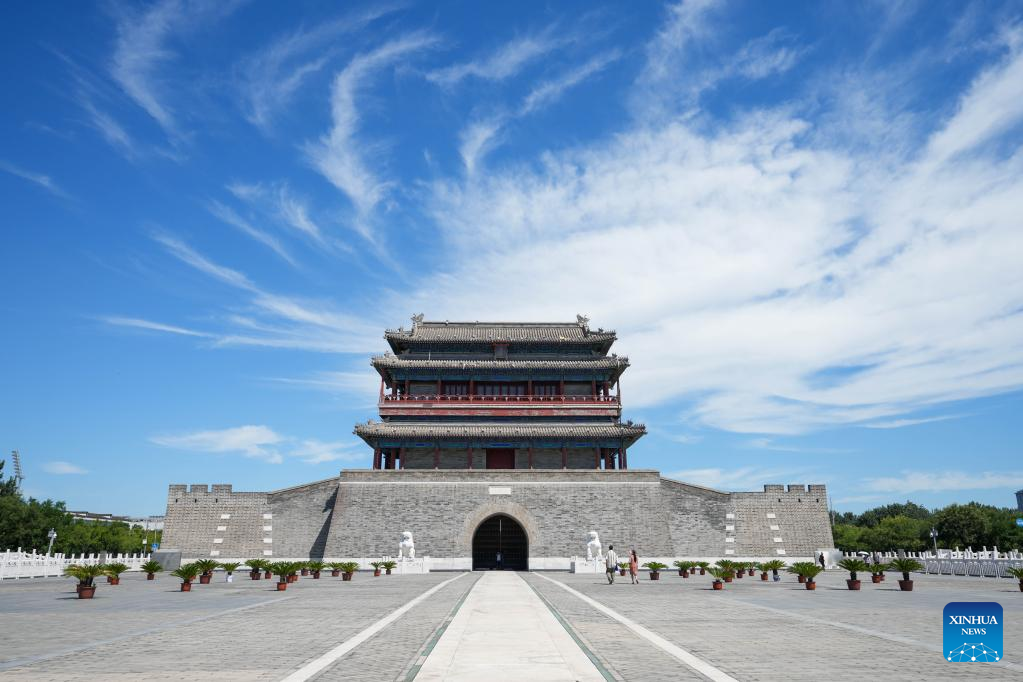
People visit the Yongdingmen Gate in Beijing, capital of China, Aug. 16, 2022. Chinese authorities have planned to recommend the Beijing Central Axis as China's 2024 world cultural heritage application project, according to the National Cultural Heritage Administration.
The Beijing Central Axis is 7.8 kilometers long, starting from the Yongding Gate in the south of the city and ending with the Drum Tower and Bell Tower in the north. Most of the major old-city buildings of Beijing are along this axis.
The central axis is the backbone of old Beijing, representing the highest achievement in the planning, design and construction of an ancient capital of Eastern civilization.
The axis was extended in 2003 as the city prepared for the 2008 Olympic Games.
Beijing authorities' general plan states that the current axis extension stretches to the Yanshan Mountain Range to the north and Beijing Daxing International Airport in the south. (Xinhua/Ju Huanzong)
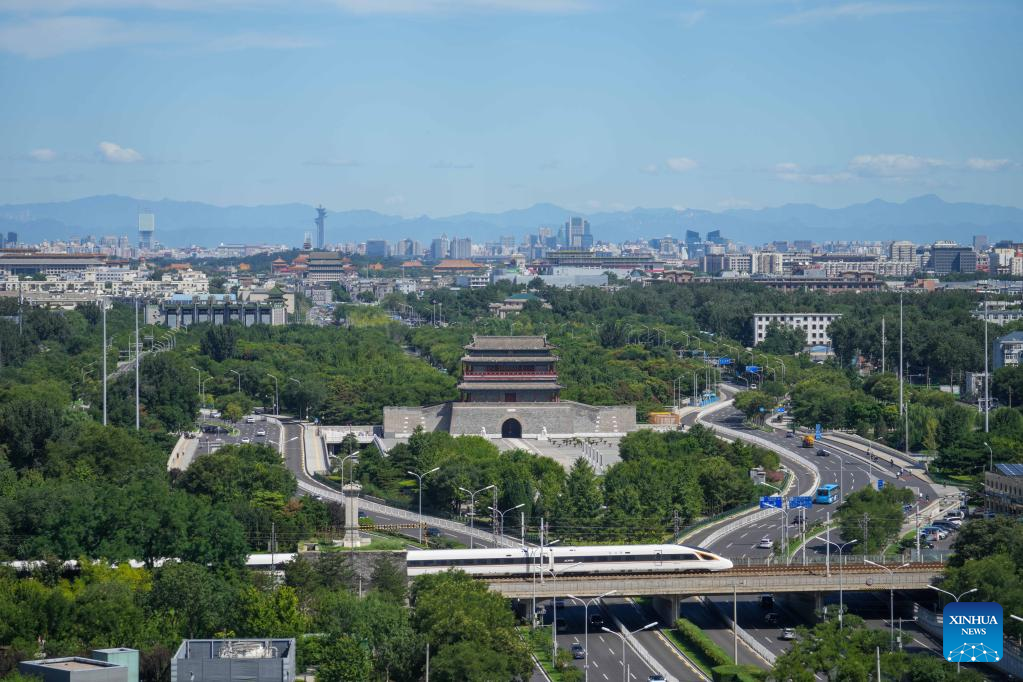
Photo taken on Aug. 16, 2022 shows a train running past Yongdingmen Gate in Beijing, capital of China. Chinese authorities have planned to recommend the Beijing Central Axis as China's 2024 world cultural heritage application project, according to the National Cultural Heritage Administration.
The Beijing Central Axis is 7.8 kilometers long, starting from the Yongding Gate in the south of the city and ending with the Drum Tower and Bell Tower in the north. Most of the major old-city buildings of Beijing are along this axis.
The central axis is the backbone of old Beijing, representing the highest achievement in the planning, design and construction of an ancient capital of Eastern civilization.
The axis was extended in 2003 as the city prepared for the 2008 Olympic Games.
Beijing authorities' general plan states that the current axis extension stretches to the Yanshan Mountain Range to the north and Beijing Daxing International Airport in the south. (Xinhua/Ju Huanzong)



